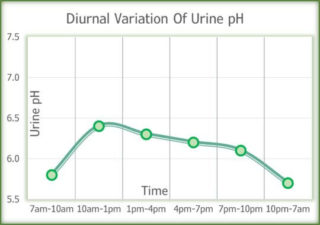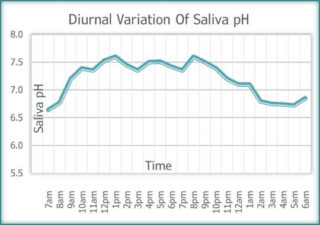Saliva Nitrate Protein Defense Against COVID-19 Infection

Salivary Nitrate Protein reduction to Nitrite protects the oral acid-base buffer system. Natural oral cell protection works best at neutral balance. But gradually fails as saliva becomes more acidic.
SARS-CoV-2 virus can infect cells in acid solutions where natural immunity fails to protect them.
We can measure Nitrates, Nitrites and Acid in Saliva. If Nitrates and Nitrites are too low, we can increase them with dietary supplements. If Acidity is still too great, we can further reduce it by restoring the oral acid-base buffer system.
The Saliva Nitrate Protein Defense provides protection against all current and future variants as well as the original SARS-CoV-2 virus.
Help measuring Nitrites and Acid in Saliva can be obtained from Herd Healthcare. Sign up for a Good Health Assessment at the end of this blog article.
Viruses are just a nuisance as long as they don’t get into cells of human tissues and organs. Kept out of cells in muscle, fat and nerves. Out of lungs, heart, brain, liver, pancreas and kidneys. Breathed in, swallowed or absorbed through skin or intestines into blood, lymph or tissue fluid. Stay safe from harm as long as it takes to get rid of them. Just so long as they don’t get into cells.
 Normal healthy cells are strongly protected from virus entry. Blood proteins, leukocytes, T Cells and Natural Killer cells carry receptors that detect and destroy harmful invaders. There are similar defense mechanisms inside cells.
Normal healthy cells are strongly protected from virus entry. Blood proteins, leukocytes, T Cells and Natural Killer cells carry receptors that detect and destroy harmful invaders. There are similar defense mechanisms inside cells.
Acid-base balance in cells, tissue fluid and blood is tightly controlled. CO2 dissolved in water is a weak acid. Any change in acid-base concentration shifts more or less CO2 in and out of solution. CO2 is breathed out into the air and liquid acids and base are excreted in urine. Restoring the original acid-base balance. At slightly alkaline level with pH, potential of hydrogen, about 7.4. Neutral pH is 7.0.
 Particles of SARS-CoV-2 circulate around in blood, lymph and interstitial fluid as folded proteins inside a closed envelope. To get inside cells, the virus particle must get attached. The envelope is covered with thousands of spike proteins that can attach to thousands of receptor sites. Acidity of the tissue fluid unfolds the virion envelope. Spike proteins on the virus attach to cell receptor sites and fusion begins. 1
Particles of SARS-CoV-2 circulate around in blood, lymph and interstitial fluid as folded proteins inside a closed envelope. To get inside cells, the virus particle must get attached. The envelope is covered with thousands of spike proteins that can attach to thousands of receptor sites. Acidity of the tissue fluid unfolds the virion envelope. Spike proteins on the virus attach to cell receptor sites and fusion begins. 1
Protective innate antibodies inhibit fusion in proportion to acidity of tissue fluid. The viral envelope unfolds about 10% at pH 7.4 but opens completely at pH 5.5. Protective antibodies inhibit attachment completely at pH 7.4 but fail to act at pH 5.5. As a result, SARS-CoV-2 spike protein attachment to cell membranes at low pH allows up to a 3-fold increase in entry. Entry into intracellular space occurs both at the cell surface and from cytosolic vesicles. 2
 Entering the host cell takes about 15 minutes. Inside the cell, the virion uses host cell functions to replicate viral molecules. Each invading virion takes over hundreds of protein actions to create about 10 infectious units. Replication cycles from entry to release of new infection units take 7 to 8 hours. The huge number of protein interactions causes many mutations which create variants among the particles released. Time from infection to symptoms is about 5 days. 3
Entering the host cell takes about 15 minutes. Inside the cell, the virion uses host cell functions to replicate viral molecules. Each invading virion takes over hundreds of protein actions to create about 10 infectious units. Replication cycles from entry to release of new infection units take 7 to 8 hours. The huge number of protein interactions causes many mutations which create variants among the particles released. Time from infection to symptoms is about 5 days. 3
Nitrate<->Nitrite<->Nitric Oxide-> (Oxygen Delivery)
Combinations of nitrogen and oxygen move back and forth supporting chemical oxidation and reduction. The amounts stored in these molecules determine how quickly they can be used and for how long.
Nitrates take up and release oxygen to support metabolism. Combined with sodium and potassium, they store and release energy. Amounts available control reactions for cardiovascular, neurological, renal and immunological function.
Acid-Base Balance From Metabolism
Normal cell metabolism combines proteins, fat and carbohydrates with oxygen to produce energy, CO2 and H2O. With scattered remnants of weak acids and bases. As well as electrolytes and fiber.
Sometimes metabolism gets interrupted before reactions with oxygen. Producing lactic acid as well as CO2 and energy. The result increases acidity and lowers pH. Making SARS-CoV-2 virions more able to fuse with cell membranes.
Lactic acid does not get balanced as quickly as CO2. Lactic acid is metabolized by tissues and organs all over the body. Eventually converted into energy, CO2 and H2O. In the meantime, CO2 is breathed out in the lungs. Until removing CO2 from blood increases acidity and decreases pH.
Excretion of excess acid by kidneys decreases pH of urine. Excretion of excess acid by salivary glands decreases pH of saliva.
Daily Variation Of Urine pH
 Daily variations in acid-base balance of urine occur in relation to meals, physical activity and sleep. Intake of food and fluid during meals increases urine pH. 4
Daily variations in acid-base balance of urine occur in relation to meals, physical activity and sleep. Intake of food and fluid during meals increases urine pH. 4
During meals, the stomach makes acid from Cl, Na, CO2 and H2O. When the acid is formed, CO2 and H2O are returned to the blood. The Cl forms acid which is secreted into the stomach. That leaves an alkaline combination of Na, CO2 and H2O which is left in the blood. The excess basic fluid in blood delivered to the kidneys is excreted in urine.
During physical activity, requirements for energy during mild exercise are matched by increased amounts of blood flow. Without any change in acid-base balance of blood.
During sleep, decreased breathing causes a higher level of CO2 in blood leaving the lungs. As a result, the acid level in urine gradually increases during the night. A urine specimen tested in the morning is usually highly acidic. Especially a second collected specimen after fully emptying the bladder.
Daily Variation Of Saliva pH
 Daily variations in acid-base balance of saliva very much follow the rate of production. During sleep, secretion of saliva is much slower than during the day. Saliva containing proteins, electrolytes and water, flows through ducts that reabsorb Cl and secrete bicarbonate. The amount of base excreted depends on rate of flow. As a result, the acidity of saliva is highest of all after several hours of sleep. 5
Daily variations in acid-base balance of saliva very much follow the rate of production. During sleep, secretion of saliva is much slower than during the day. Saliva containing proteins, electrolytes and water, flows through ducts that reabsorb Cl and secrete bicarbonate. The amount of base excreted depends on rate of flow. As a result, the acidity of saliva is highest of all after several hours of sleep. 5
Energy for metabolism includes production of lactate. Especially with low levels of serum bicarbonate and low urine pH. Further decreasing protective effects of bicarbonate during rest.
Defense Against Viral Infection
The most obvious treatment to prevent severe illness and viral replication is initial, repeat and booster vaccination against COVID-19. Except for known diagnosed allergy to some component of a COVID-19 vaccine.
While continuing all precautions against exposure to spread of COVID-19.
Indicators of Decreased Risk of Infection and Severity of Illness:
•Morning saliva pH: at least 6.0
•Morning urine pH: at least 6.0
Conditions Increasing Risk for Infection, Vaccination Breakthrough and Severe Illness from COVID-19:
•Metabolic disease including hypertension, obesity and type 2 diabetes
•Kidney disease with metabolic acidosis and renal failure
•Lung disease with respiratory acidosis and COPD
•Autoimmune disease with chronic inflammation
•Organ transplants with medication to prevent rejection
•Cancer causing immunodeficiency
Treatment of organ dysfunction and chronic metabolic dysfunction requires correction of the underlying medical condition. As much as possible. Giving special attention to compliance with prescribed medical treatment. Including nutrition, physical activity and sleep patterns. Also, management of behavioral and psychological factors.
Services From Herd Healthcare

We will assess individual features of health to make recommendations for increasing personal safety from infection and illness.
 Results of laboratory tests combined with personal information can be used to determine natural features and strength of good health protecting against infection and illness.
Results of laboratory tests combined with personal information can be used to determine natural features and strength of good health protecting against infection and illness.
REFERENCES
1. Cohen FS. How Viruses Invade Cells. Biophysical Journal 2016;110(5):1028-1032.
https://doi.org/10.1016/j.bpj.2016.02.006
2. Tongqing Z, Tsybovsky Y, Olia AS, et al. Cryo-EM Structures Delineate a pH-Dependent Switch that Mediates Endosomal Positioning of SARS-CoV-2 Spike Receptor-Binding Domains. bioRxiv 2020.07.04.187989.
https://doi.org/10.1101/2020.07.04.187989
3. Bar-On YM, Flamholz A, Phillips R, Milo R (2020) Science Forum: SARS-CoV-2 (COVID-19) by the numbers eLife 9:e57309.
https://doi.org/10.7554/eLife.57309
4. Cameron M, Maalouf NM, Poindexter J, et al. The diurnal variation in urine acidification differs between normal individuals and uric acid stone formers. Kidney International 2012;81(11):1123-1130.
https://doi.org/10.1038/ki.2011.480
5. Choi J, Lyons K, Kieser J et al. Diurnal variation of intraoral pH and temperature. BDJ 2017 Open 3, 17015
https://doi.org/10.1038/bdjopen.2017.15




